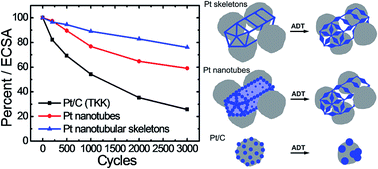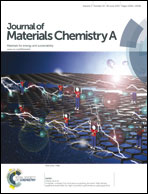Synthesis and structural evolution of Pt nanotubular skeletons: revealing the source of the instability of nanostructured electrocatalysts†
Abstract
The durability of Pt catalysts in polymer membrane electrolyte fuel cells (PEMFCs) is critical to successful implementation of this clean energy technology in transportation and stationary applications. Despite reports on a variety of Pt nanostructures with improved durability, a clear understanding of the structure–durability relationship is still missing as a rigorous correlative investigation is lacking. Using five-fold twinned Pd nanowires as templates, we have prepared Pt nanotubular skeleton structures which duplicate the crystal structure of the template. By comparing the durability of these structures with commercial Pt/C catalysts and Pt nanotubes, we found that grain boundaries in Pt nanocatalysts contribute most to the instability of the catalyst structures. These results not only highlight a strategy to prepare more durable fuel cell catalysts, but also provide a new method to prepare elongated Pt catalysts with controlled crystal structures, which together will perpetuate the commercial success of this green energy conversion technology.

- This article is part of the themed collection: 2015 Journal of Materials Chemistry A Hot Papers


 Please wait while we load your content...
Please wait while we load your content...